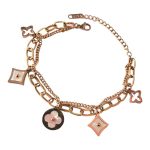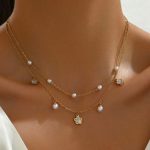Introduction to DIY Necklace Repair
Tackling a broken necklace can be daunting. Yet, it’s a skill worth mastering for any jewelry lover. A DIY approach saves you time and money. Plus, it feels rewarding to restore a treasured piece yourself. This guide simplifies necklace repair, giving you the confidence to fix common issues.
To start, you’ll need some basic tools. With these in hand, you’ll be set to mend most breaks or damages to your favorite necklaces. It’s incredible what you can accomplish with a bit of know-how. Whether you’re soldering broken links or replacing a clasp, this step-by-step guide will walk you through. Let’s dive in and turn you into a necklace-fixing pro.
Essential Tools for Necklace Repair
When starting a DIY necklace repair project, having the right tools is crucial. They make the job easier and improve the chances of a lasting repair. Here are some essential tools you’ll need:
- Jewelry pliers or needle-nose pliers for gripping and bending metal.
- Fine wire cutters for snipping chains and wires.
- A soldering iron or torch for melting solder during the repair.
- Tweezers for holding small parts in place.
- A magnifying glass to see tiny details better.
- A soft cloth for cleaning and polishing the necklace.
- A work surface with good lighting to clearly see what you’re doing.
With these essential tools, you’ll be prepared to tackle a variety of necklace repairs.
Identifying Different Types of Clasps and Jump Rings
Different necklaces have different kinds of clasps and jump rings. Recognizing these is key to effective repairs. Some common types include:
- Lobster clasps: These have a self-closing mechanism and are very secure.
- Spring ring clasps: They open when you push on a lever and snap closed automatically.
- Toggle clasps: These consist of a ring on one end and a bar on the other.
- Magnetic clasps: They use magnets to close and are very easy to use.
For jump rings, you’ll usually encounter standard ones that are circular and open or close with a twist. There are also split rings, resembling a tiny key ring. Knowing which type your necklace uses helps you pick the right approach for repair.

Techniques for Fixing Broken Necklace Links
To fix a broken necklace, apply one of several methods, depending on the damage.
Soldering Broken Links for a Durable Fix
Solder broken necklace links with a low melting point alloy. Ensure a clean, dry surface before starting. Heat the alloy with a torch until it flows, bonding the links together.
Wire Wrapping Technique for Link Repair
Use wire wrapping for a no-solder fix. Cut wire to length, thread through links, and twist to secure. Repeat for strength and trim excess wire carefully.
Using Glue for Minor Link Issues
For a quick fix, use strong adhesive on clean link surfaces. Apply carefully, let dry fully. Note that glue may not hold under strain or with heavy use.
Clasp Replacement and Installation
When clasps break, measure a new one against the old. Use pliers to remove the broken clasp, then attach a new one, ensuring it clicks shut securely.
Step-by-Step Guide to Fix a Broken Necklace Clasp
Fixing a broken necklace clasp can feel overwhelming. This guide will provide a simple step-by-step process.
Examining the Damage and Removing the Old Clasp
Start by carefully looking at the broken clasp. Use a magnifying glass to see small details. Identify if it’s bent, stuck, or entirely broken. If you can, try gently bending it back with jewelry pliers. If that fails, you’ll need to remove it. Use pliers to open any jump rings. Then, detach the old clasp from your necklace chain.
Attaching a New Clasp and Testing the Repair
First, select a new clasp that matches your necklace. Open the jump ring with your pliers and attach the new clasp. Close the jump ring securely. Make sure there’s no gap. Gently pull on the clasp to see if it holds well. If it does, your repair is a success. If not, you may need to repeat the process or seek professional help.
When done correctly, your necklace should be as good as new. With patience and the right tools, you can avoid the cost of professional repairs. Keep in mind, a well-done repair will last longer and look better.

Tips for Preventing Necklace Breakage
Preventing breakage is key to keeping necklaces beautiful. Simple tips can help you avoid common issues. Here’s what you need to know to prevent breaks.
Choosing the Right Necklace Chains
When picking chains, think about their strength and how you’ll wear them. Thicker chains often last longer and can handle more wear. If you prefer subtle looks, go for quality over size. Look for well-made thin chains to ensure they are durable. Choose chains with solid clasps and sturdy links to reduce the risk of breakage.
Proper Necklace Storage and Care
Taking care of necklaces helps prevent tangles and damage. After wearing, clean your necklace with a soft cloth. Hang it or lay it flat in a box with divided spaces. Keep necklaces away from harsh chemicals, such as perfumes or cleaners. Regularly check clasps and links for wear. If they show signs of wear, fix them before they break.
Concluding Thoughts on Necklace Maintenance and Repair
Maintaining and repairing necklaces is a valuable skill for jewelry enthusiasts. Regular inspection helps spot problems early. Quick repairs prevent small issues from getting worse. This guide aimed to equip you with the know-how to mend broken links at home. We covered essential tools, techniques like soldering, and clasp replacement.
Importance of Regular Inspection and Quick Repairs
Inspect your necklace often for signs of wear or damage. Quick repair work can save your favorite pieces. Remember, repairing a broken chain or clasp at home is often simple. It can extend the life of your jewelry significantly. With practice, you become better at these DIY fixes.
Simple tools and some effort can go a long way. Inspect clasps and links each time you wear a necklace. Fix any problems before they lead to a break. Caring for your necklaces means they will stay beautiful for longer. And it’s always satisfying to know you can fix a treasured piece on your own.

Frequently Asked Questions
Addressing Common Concerns About Necklace Repair
Repairing a necklace at home? It’s common to have questions. Below, we address some frequent concerns about fixing broken necklaces.
Can I fix a completely broken necklace chain myself?
Yes, even a chain split in half can be mended. The method depends on the material and break type.
Is glue a reliable fix for a broken necklace?
Glue offers a quick fix but often lacks durability. It may not withstand regular use.
How much does it usually cost to fix a broken chain?
Prices vary. Simple fixes might cost between $10 to $30. More complex repairs can exceed $50.
Are thin and delicate necklaces harder to repair?
Delicate necklaces require careful handling. A jeweler can provide a proper fix without causing damage.
Can I use multiple clasps to repair a necklace?
Yes, multiple clasps can distribute weight and reduce future breakage. Ensure they’re securely attached.
These questions cover just the basics. With the right tools and techniques, most necklace repairs can be done at home, saving you time and money. Remember, patience and practice make perfect when it comes to jewelry repair.


